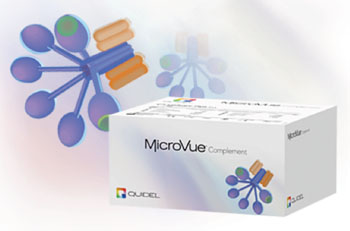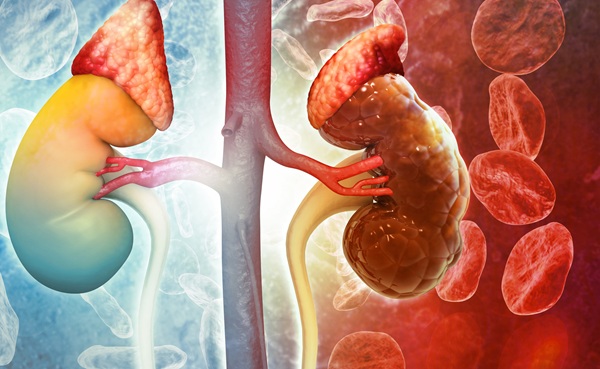Biomarker Outperforms Current Gold Standard to Detect Brain Shunt Infections
|
By LabMedica International staff writers Posted on 15 Sep 2016 |

Image: The MicroVue complement sC5b-9 Plus enzyme immunoassay kit (Photo courtesy of Quidel Corporation).
Children treated with cerebrospinal fluid (CSF) shunts to manage hydrocephalus frequently develop shunt failure and/or infections, conditions that present with overlapping symptoms.
The potential life-threatening nature of shunt infections requires rapid diagnosis; however, traditional microbiology is time consuming, expensive, and potentially unreliable. A quick and accurate test for bacterial infection in brain shunts or meningitis would improve the quality and efficiency of patient care and patient outcomes. Such a test would also lower health care expenses by avoiding needless hospitalization and treatment.
Scientists at the University of Alabama (Birmingham, AL, USA) prospectively enrolled 198 consecutive undergoing evaluation and treatment for newly diagnosed hydrocephalus, shunt infection, and versus malfunction. Study samples were collected at the same time as routine lab specimens to provide corresponding laboratory results for each specimen (glucose, protein, hematology indices, gram stain, and culture). Samples were labeled and stored at –20 °C and/or –80 °C for a period of one week on average prior to analysis.
Cerebrospinal fluid (CSF) CSF was assayed for the soluble membrane attack complex (sMAC) by enzyme-linked immunosorbent assay (ELISA) in patients with suspected shunt failure or infection. CSF was obtained at the time of initial surgical intervention. Statistical analysis was performed to assess the diagnostic potential of sMAC in pyogenic-infected versus non-infected patients. Soluble MAC was quantitated using the MicroVue complement sC5b-9 Plus enzyme immunoassay (Quidel Corporation, Athens, OH, USA). The lower limit of detection for the assay was 3.7 ng/mL.
The team used appropriately adjusted cutoff values for maximum sensitivity and specificity, and the sMAC was able to detect 14 of 15 infections in the 248 patients, while the current diagnostic gold standard of bacterial culture was less accurate, detecting only 11 of the 15 infections. At the best cutoff value, the test had excellent diagnostic capability with a sensitivity of 93% and a specificity of 86%. Children with pyogenic shunt infection had significantly increased sMAC levels compared with non-infected patients (3,211 ± 1,111 ng/mL versus 26 ± 3.8 ng/mL).
In infected patients undergoing serial CSF draws, sMAC levels were prognostic for both positive and negative clinical outcomes. Children with delayed, broth-only growth of commensal organisms such as Propionibacterium acnes, Staphylococcus epidermidis had the lowest sMAC levels (7.96 ± 1.7 ng/mL), suggesting contamination rather than shunt infection. The study was first published online on July 7, 2016, in the Journal of Clinical Investigation Insight.
Related Links:
University of Alabama
Quidel
The potential life-threatening nature of shunt infections requires rapid diagnosis; however, traditional microbiology is time consuming, expensive, and potentially unreliable. A quick and accurate test for bacterial infection in brain shunts or meningitis would improve the quality and efficiency of patient care and patient outcomes. Such a test would also lower health care expenses by avoiding needless hospitalization and treatment.
Scientists at the University of Alabama (Birmingham, AL, USA) prospectively enrolled 198 consecutive undergoing evaluation and treatment for newly diagnosed hydrocephalus, shunt infection, and versus malfunction. Study samples were collected at the same time as routine lab specimens to provide corresponding laboratory results for each specimen (glucose, protein, hematology indices, gram stain, and culture). Samples were labeled and stored at –20 °C and/or –80 °C for a period of one week on average prior to analysis.
Cerebrospinal fluid (CSF) CSF was assayed for the soluble membrane attack complex (sMAC) by enzyme-linked immunosorbent assay (ELISA) in patients with suspected shunt failure or infection. CSF was obtained at the time of initial surgical intervention. Statistical analysis was performed to assess the diagnostic potential of sMAC in pyogenic-infected versus non-infected patients. Soluble MAC was quantitated using the MicroVue complement sC5b-9 Plus enzyme immunoassay (Quidel Corporation, Athens, OH, USA). The lower limit of detection for the assay was 3.7 ng/mL.
The team used appropriately adjusted cutoff values for maximum sensitivity and specificity, and the sMAC was able to detect 14 of 15 infections in the 248 patients, while the current diagnostic gold standard of bacterial culture was less accurate, detecting only 11 of the 15 infections. At the best cutoff value, the test had excellent diagnostic capability with a sensitivity of 93% and a specificity of 86%. Children with pyogenic shunt infection had significantly increased sMAC levels compared with non-infected patients (3,211 ± 1,111 ng/mL versus 26 ± 3.8 ng/mL).
In infected patients undergoing serial CSF draws, sMAC levels were prognostic for both positive and negative clinical outcomes. Children with delayed, broth-only growth of commensal organisms such as Propionibacterium acnes, Staphylococcus epidermidis had the lowest sMAC levels (7.96 ± 1.7 ng/mL), suggesting contamination rather than shunt infection. The study was first published online on July 7, 2016, in the Journal of Clinical Investigation Insight.
Related Links:
University of Alabama
Quidel
Latest Immunology News
- Blood Test Could Detect Adverse Immunotherapy Effects
- Routine Blood Test Can Predict Who Benefits Most from CAR T-Cell Therapy
- New Test Distinguishes Vaccine-Induced False Positives from Active HIV Infection
- Gene Signature Test Predicts Response to Key Breast Cancer Treatment
- Chip Captures Cancer Cells from Blood to Help Select Right Breast Cancer Treatment
- Blood-Based Liquid Biopsy Model Analyzes Immunotherapy Effectiveness
- Signature Genes Predict T-Cell Expansion in Cancer Immunotherapy
- Molecular Microscope Diagnostic System Assesses Lung Transplant Rejection
- Blood Test Tracks Treatment Resistance in High-Grade Serous Ovarian Cancer
- Luminescent Probe Measures Immune Cell Activity in Real Time
- Blood-Based Immune Cell Signatures Could Guide Treatment Decisions for Critically Ill Patients
- Novel Tool Predicts Most Effective Multiple Sclerosis Medication for Patients
- Companion Diagnostic Test for CRC Patients Identifies Eligible Treatment Population
- Novel Tool Uses Deep Learning for Precision Cancer Therapy
- Companion Diagnostic Test Identifies HER2-Ultralow Breast Cancer and Biliary Tract Cancer Patients
- Novel Multiplex Assay Supports Diagnosis of Autoimmune Vasculitis
Channels
Clinical Chemistry
view channel
POC Breath Diagnostic System to Detect Pneumonia-Causing Pathogens
Pseudomonas aeruginosa is a major cause of hospital-acquired and ventilator-associated pneumonia, particularly in lung transplant recipients and patients with structural lung disease. Its ability to form... Read more
Online Tool Detects Drug Exposure Directly from Patient Samples
Doctors often rely on patient interviews and medical records to determine what medications a person has taken, but this information is frequently incomplete. People may forget drugs they used, take over-the-counter... Read moreMolecular Diagnostics
view channel
Blood Biomarker Improves Early Brain Injury Prognosis After Cardiac Arrest
After a cardiac arrest, many patients remain unconscious for days, leaving doctors and families facing uncertainty about whether meaningful recovery is possible. Current tools to assess brain damage, including... Read more
Biomarkers Could Identify Patients at High Risk of Severe AKI After Major Surgery
Acute kidney injury is one of the most common and dangerous complications after major surgery, particularly among patients in intensive care. Even mild impairment of kidney function can lead to long-term... Read more
CLIA Test Identifies Head and Neck Cancer Recurrence from Post-Surgical Lymphatic Fluid
While the lymphatic system’s critical role in metastasis has long been recognized, routine access to patient lymph has been elusive. Now, a non-invasive process can access lymph through the collection... Read moreHematology
view channel
MRD Tests Could Predict Survival in Leukemia Patients
Acute myeloid leukemia is an aggressive blood cancer that disrupts normal blood cell production and often relapses even after intensive treatment. Clinicians currently lack early, reliable markers to predict... Read more
Platelet Activity Blood Test in Middle Age Could Identify Early Alzheimer’s Risk
Early detection of Alzheimer’s disease remains one of the biggest unmet needs in neurology, particularly because the biological changes underlying the disorder begin decades before memory symptoms appear.... Read more
Microvesicles Measurement Could Detect Vascular Injury in Sickle Cell Disease Patients
Assessing disease severity in sickle cell disease (SCD) remains challenging, especially when trying to predict hemolysis, vascular injury, and risk of complications such as vaso-occlusive crises.... Read more
ADLM’s New Coagulation Testing Guidance to Improve Care for Patients on Blood Thinners
Direct oral anticoagulants (DOACs) are one of the most common types of blood thinners. Patients take them to prevent a host of complications that could arise from blood clotting, including stroke, deep... Read moreImmunology
view channelBlood Test Could Detect Adverse Immunotherapy Effects
Immune checkpoint inhibitors have transformed cancer treatment, but they can also trigger serious immune-related adverse events that damage healthy organs and may become life-threatening if not detected early.... Read more
Routine Blood Test Can Predict Who Benefits Most from CAR T-Cell Therapy
CAR T-cell therapy has transformed treatment for patients with relapsed or treatment-resistant non-Hodgkin lymphoma, but many patients eventually relapse despite an initial response. Clinicians currently... Read morePathology
view channel
Rapid Low-Cost Tests Can Prevent Child Deaths from Contaminated Medicinal Syrups
Medicinal syrups contaminated with toxic chemicals have caused the deaths of hundreds of children worldwide, exposing a critical gap in how these products are tested before reaching patients.... Read more
Tumor Signals in Saliva and Blood Enable Non-Invasive Monitoring of Head and Neck Cancer
Head and neck cancers are among the most aggressive malignancies worldwide, with nearly 900,000 new cases diagnosed each year. Monitoring these cancers for recurrence or relapse typically relies on tissue... Read more
Common Health Issues Can Influence New Blood Tests for Alzheimer’s Disease
Blood-based tests for Alzheimer’s disease are transforming diagnosis by offering a simpler alternative to spinal taps and brain imaging. However, many people evaluated at memory clinics also live with... Read more
Blood Test Formula Identifies Chronic Liver Disease Patients with Higher Cancer Risk
Chronic liver disease affects millions worldwide and can progress silently to hepatocellular carcinoma (HCC), one of the deadliest cancers globally. While surveillance guidelines exist for patients with... Read moreTechnology
view channel
Machine Learning Models Diagnose ALS Earlier Through Blood Biomarkers
Amyotrophic lateral sclerosis (ALS) is a rapidly progressive neurodegenerative disease that is notoriously difficult to diagnose in its early stages. Early symptoms often overlap with other neurological... Read more
Artificial Intelligence Model Could Accelerate Rare Disease Diagnosis
Identifying which genetic variants actually cause disease remains one of the biggest challenges in genomic medicine. Each person carries tens of thousands of DNA changes, yet only a few meaningfully alter... Read moreIndustry
view channel
BD and Penn Institute Collaborate to Advance Immunotherapy through Flow Cytometry
BD (Becton, Dickinson and Company, Franklin Lakes, NJ, USA) has entered into a strategic collaboration with the Institute for Immunology and Immune Health (I3H, Philadelphia, PA, USA) at the University... Read more




 assay.jpg)















